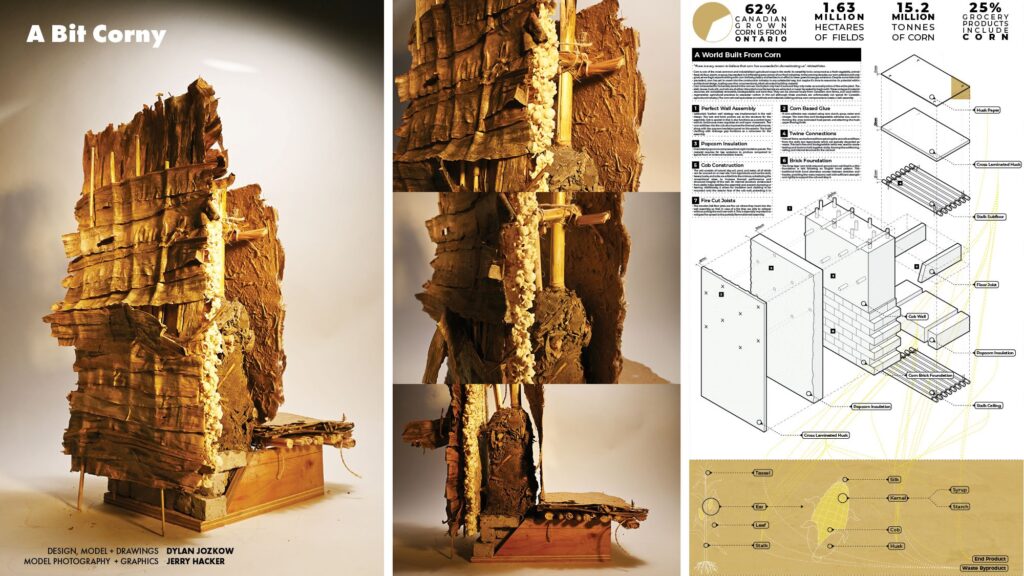Work by Prof. Jerry Hacker’s graduate course among winners of OAA Shift 2025 Challenge
March 31, 2025

Model photography and graphics: Jerry Hacker
The Ontario Association of Architects (OAA) has named student work from the Advanced Buildings Systems graduate course, led by Assistant Professor Jerry Hacker, as one of six winners of the OAA’s SHIFT2025 Challenge competition.
Hacker, a registered architect, entered work by 11 Master of Architecture students at the Azrieli School of Architecture & Urbanism in a submission titled Speculative Assemblies, from Pine Needles to Pressed Coffee.
“This speculative research asks: ‘Is it possible to conceive of a cold weather, toxin-free, regenerative wall assembly, capable of creating more environmental healing than damage in the world?” he wrote.

Model photography and graphics: Jerry Hacker

Model photography and graphics: Jerry Hacker
Every two years, the OAA, the provincial regulator of architectural practice, invites participation in the Shift Challenge, which it describes as an “aspirational program…to highlight the distinct contribution which the architecture profession and architectural thinking bring to addressing key societal issues.”
This year’s theme was “Reshaping Communities.” It solicited architects to make proposals taking on the climate crisis, housing, and social change.
The six projects were chosen by a jury of experts for their creativity, feasibility, and emphasis on sustainability, while reflecting diverse strategies needed to create adaptable, inclusive, and climate-conscious communities, says the OAA.
The other five winners explored possible buildings and communities of building, including urban renewal and designs tailored for emergency response. The Carleton University architecture students’ work is special in considering what comes before and after the creation of buildings, from resource extraction to disassembly and decomposition.

Model photography and graphics: Jerry Hacker

Model photography and graphics: Jerry Hacker
Hacker’s submission highlighted work by the following students: Madison Bolyea, Mikhala Gibson, Theo Jemtrud, Jeremie Lafleche, Dylan Jozkow, Mu Qu Jennifer Liu, Simon Martignago, Keegan Metheringham, Emma Monfette, Daphne Stams, and Vincent Tourangeau.
The Speculative Assemblies project, says Hacker, “conceives a sustainable future by reimagining building practices eliminating plastics, toxins, and exploitative supply chains — through regenerative, biodegradable materials that promote biodiversity, human health, and environmental renewal, while addressing urgent climate and ecological emergencies.”
In contrast, contemporary building construction in Canada frequently employs many petrochemical-derived materials, dependent on exploitative supply chains, that result in damaging ‘forever’ chemical by-products and microplastic debris entering food, bodies, and the environment.
Although monetarily cheap on the surface, these materials routinely mask the hidden costs to the world’s ecosystems and human health.
“Specifying healthier materials is only half the battle,” writes Hacker. “Regenerative resource design and thinking requires us to reconsider supply chains, sites of material extraction, sites of material processing, material transportation, material warehousing, storage, and end-of-life practices.”

Model photography and graphics: Jerry Hacker

Model photography and graphics: Jerry Hacker
During the fall 2024 course, 50 students researched potential materials for construction, including hemp, lime plaster, rammed earth, pine resin, denim, cork, cob, clay, coffee grounds, leaf mulch, cellulose, beeswax, and bioplastic.
The goal of the research was to conceive, design, draw, and construct a healthy, non-toxic regenerative, cold weather, wall-to-floor, wall-to-foundation, or wall-to-roof detail, suitable for disassembly.
Hacker notes that the three categories of structure, insulation, cladding and linings, are responsible for most of the construction material in a light-frame building.
“If these three areas can be radically improved under the lens of regenerative biogenic construction principles, the bulk of the construction materials could be moved well away from the conventional materials that have blossomed as a result of the petrochemical revolution,” he says.
The students began by studying and taking apart conventional construction assemblies. Then, they were tasked with making a new speculative wall and floor assembly, producing diverse results.
“We must consciously design the ways in which materials and assemblies go together and therefore come apart (or not) in the end,” says Hacker. “These decisions have significant repercussions on the environmental stewardship and carbon footprint of a building, as well as the long-term prosperity of human and planetary health.”

Model photography and graphics: Jerry Hacker

Model photography and graphics: Jerry Hacker
The six selected projects will be celebrated at the Westin Ottawa during a special event on May 15 as part of the OAA Conference. The selections will also be featured in a publication and online for the broader public to explore.
“Each of these winning projects underscores the importance of designing for adaptability in the face of climate change, technological advancements, and societal shifts,” says OAA President Ted Wilson. “The OAA congratulates these selections for their exceptional contributions to reimagine the future of communities in Canada and beyond.”

Model photography and graphics: Jerry Hacker

Model photography and graphics: Jerry Hacker